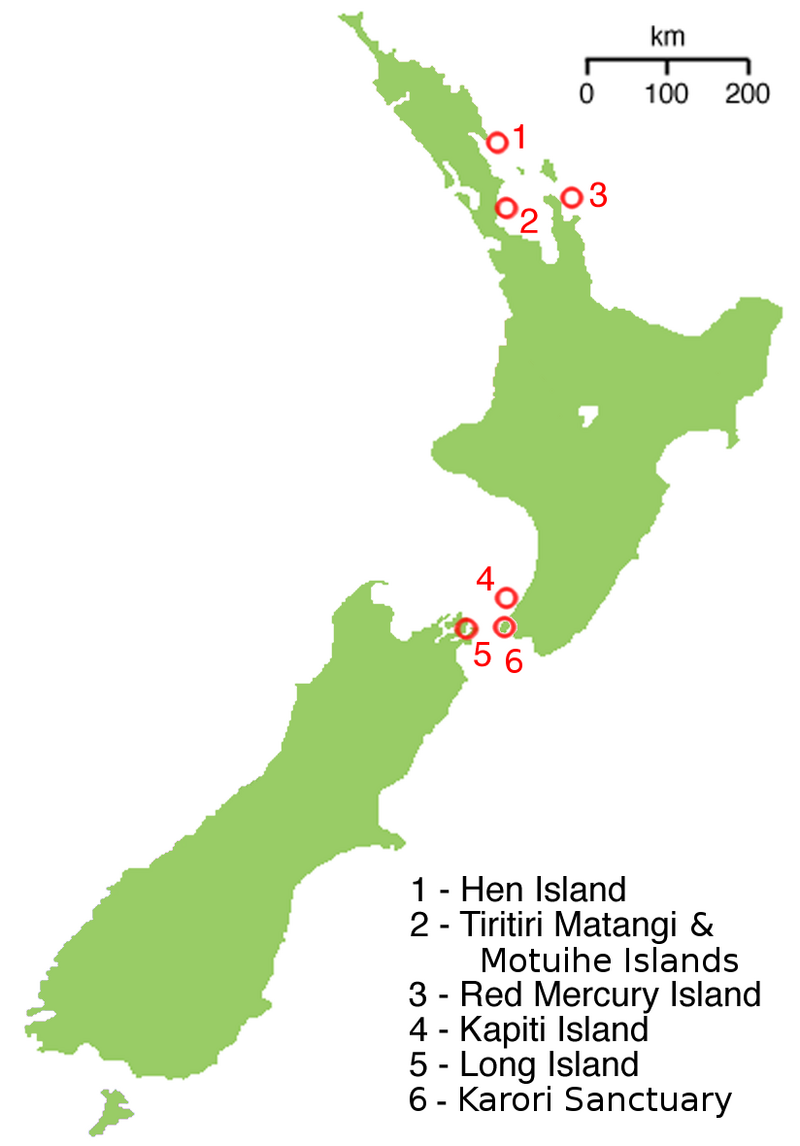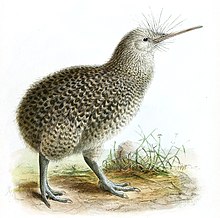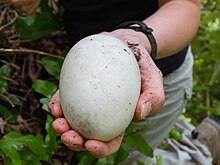Illustration by G. D. Rowley, 1870s
The little spotted kiwi was first described in 1847 by John Gould from a specimen obtained by F. Strang. The locality is not recorded but it probably came from Nelson or Marlborough. In 1873, Henry Potts published an account of its habits and about this time specimens were collected in South Westland and sent to England.[2]
Description
The little spotted kiwi has a length of 35 to 45 cm (14–18 in) and the weight of the male is 0.88 to 1.36 kg (1.9–3.0 lb) and the female weighs 1 to 1.95 kg (2.2–4.3 lb), making it the smallest species of kiwi.[7] Their feathers are pale-mottled grey, with fine white mottling, and are shaggy looking.[8][full citation needed] They lack aftershafts and barbules. They have large vibrissae feathers around the gape. They lack a tail, but have a small pygostyle.[2] Their bill is ivory and long and their legs are pale.[8]Range and habitat
Studies on Kapiti Island show that they prefer flax, seral, and older forest habitats. Lower numbers are found in rough grassland and scrub, indicating that either they prefer other habitats or they simply need a larger territory to support themselves in these areas.[8]Behaviour
Little spotted kiwis eat grubs and other small insects that are found underground, and occasionally eat berries. Using its sharp talons and long beak, it digs into the ground and then shoves its long beak down the softened ground. Since they can't fly to get to insects or food on trees and their eyesight is very poor, they depend on a keen sense of smell, long beak and talons.[2]They are also nocturnal. Little spotted kiwi call occasionally each night to advertise territory and to maintain contact with partners. Often pairs will duet. They are very territorial, and fight conspecifics with their sharp claws, resulting in lots of feathers on the ground.Reproduction
Egg in hand, Zealandia
Conservation
Burrow entrance, Zealandia
As the smallest species of kiwi, the little spotted kiwi would be very vulnerable to the main kiwi predators like cats, dogs, and stoats, however it is now restricted to several off-shore island reserves (mainly Kapiti Island) which are mostly free of introduced predators. The little spotted kiwi's conservation status is listed as "range restricted" (by 'Save the Kiwi'), with a growing population. Formerly classified as "vulnerable" by the IUCN,[10] it was suspected to be more numerous than generally assumed. Following the evaluation of its population size, this was found to be correct, and it was consequently downlisted to "near threatened" status in 2008 as, although not rare, its small range puts it at risk. The lack of predators, apart from weka (Gallirallus australis), is important to its increasing numbers. It has an occurrence range of 31 km2 (12 sq mi), and a population of 1600 was estimated in the year 2012.[1]
Apteryx owenii
A. o. owenii
†A. o. iredelai North Island little spotted kiwi

The distribution of little spotted kiwi




No comments:
Post a Comment
Note: Only a member of this blog may post a comment.